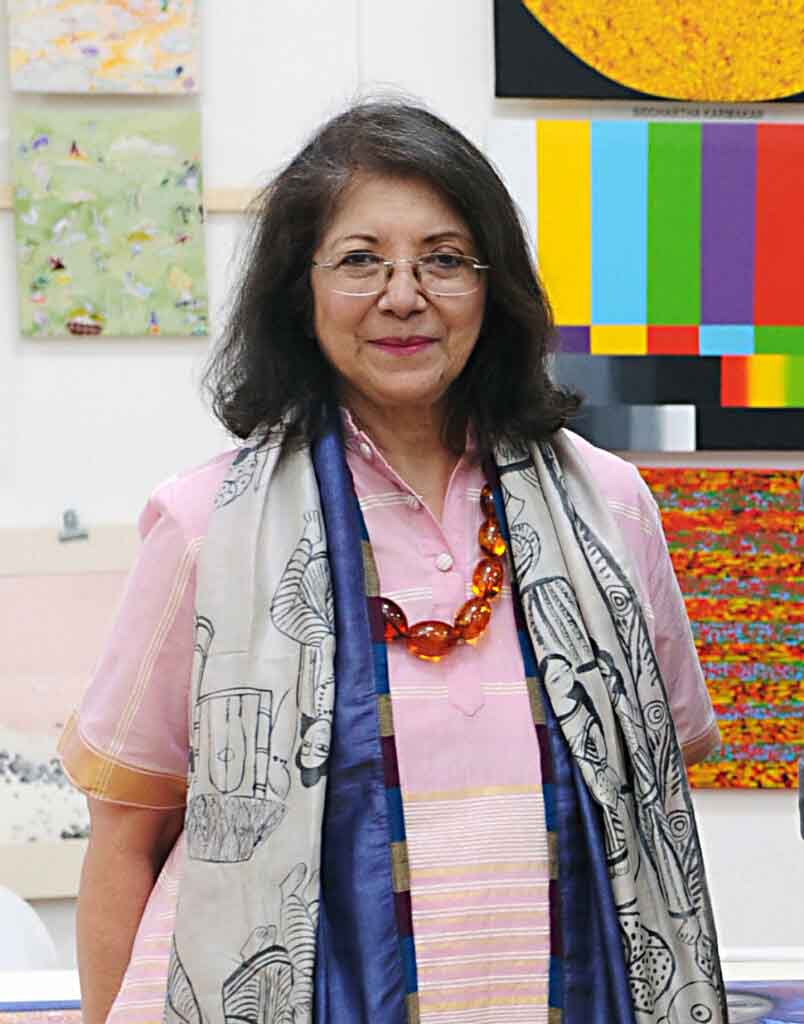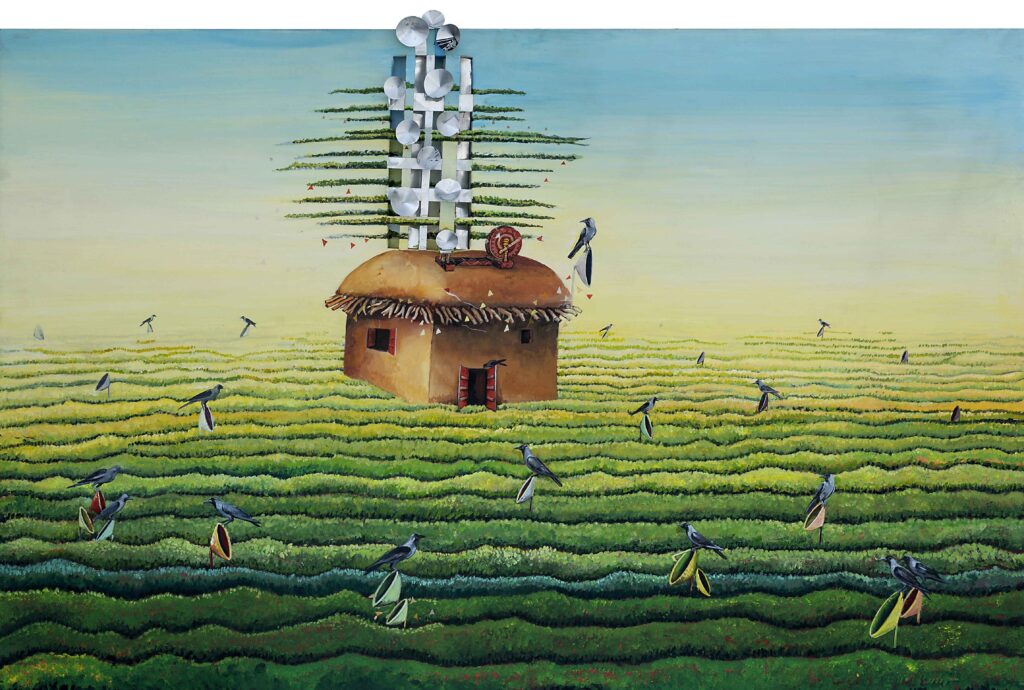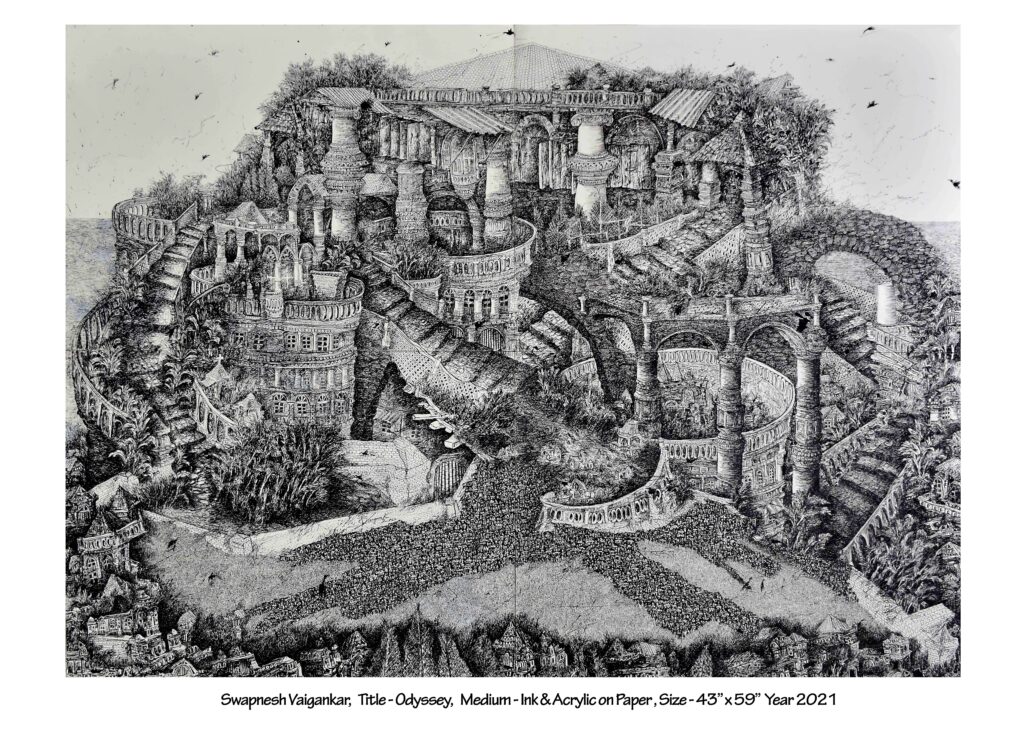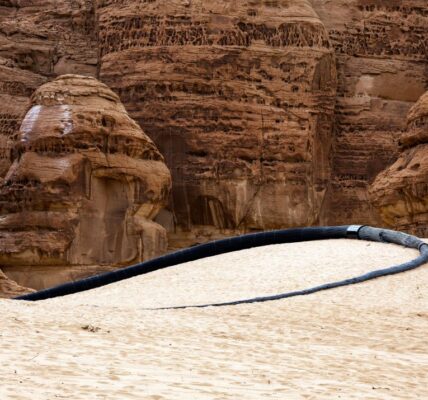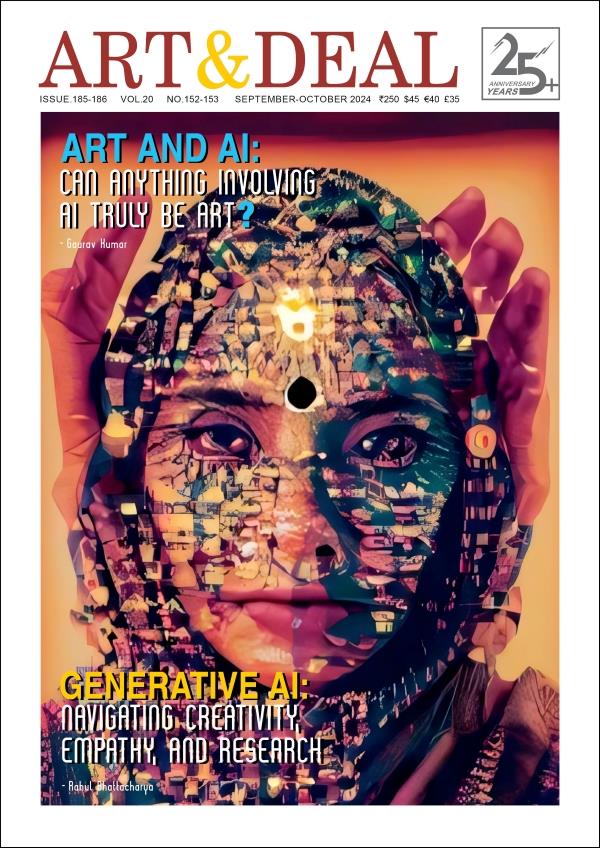Rakhi Sarkar is indeed a well-known figure in the art world, Rakhi Sarkar is a name synonymous with the promotion of art and culture in Kolkata, India, and beyond. As the eminent art curator and Director of the Centre of International Modern Art (CIMA), a prominent art gallery in Kolkata, she has made significant contributions to the world of art and has played a pivotal role in shaping the contemporary art scene in India. I had the pleasure of meeting her on October 12th, 2023 at The Millennials: Art by Generation Next exhibition. This exhibition (15th September –15th October 2023) showcases the success stories of fifteen finalists and winners from across four editions of the CIMA Awards. It has been organized by Saurabh Singhvi through his art gallery at New Delhi, Art Magnum. The exhibition includes paintings, graphics, installations, and sculptures, providing a holistic experience. I was impressed by Singhvi’s remarkable initiative and the work of all the young artists featured in the exhibition.
In this interview, we will explore Rakhi Sarkar’s remarkable journey, her contributions to the art world, and her enduring impact. Rakhi Sarkar’s journey in the world of art curation began in the late 20th century. Her vision was to create a platform that would showcase contemporary Indian and international art while fostering dialogue and engagement. This vision gave birth to the Centre of International Modern Art (CIMA) in 1993. CIMA quickly became a hub for art connoisseurs, artists, and enthusiasts, providing them with a space to explore and appreciate modern and contemporary art. Under Sarkar’s guidance, CIMA emerged as a dynamic institution, hosting exhibitions, discussions, and workshops that enriched the artistic landscape of Kolkata.
One of the most notable aspects of Rakhi Sarkar’s work at CIMA is her dedication to promoting Indian artists on the global stage. She understood the importance of giving Indian artists the exposure they deserved, and through CIMA, she facilitated collaborations with international artists and institutions. These interactions not only helped Indian artists gain recognition abroad but also brought global art trends to the local scene, fostering a vibrant exchange of ideas. Sarkar’s commitment to showcasing a diverse range of art forms is another highlight of her work. CIMA’s exhibitions have covered a wide spectrum of artistic expressions, from painting and sculpture to photography and new media. This diversity in the selection of art has made CIMA a melting pot of creativity, attracting artists from all corners of the world.
Rakhi Sarkar’s influence extends beyond the walls of CIMA. She has been instrumental in curating exhibitions in prestigious venues worldwide, connecting Indian artists with international audiences. Her tireless efforts have not only elevated the profile of Indian art but have also played a significant role in fostering cultural exchange and diplomacy. Sarkar’s support for emerging artists is also noteworthy. She has been a mentor to many young talents, providing them with opportunities to showcase their work and guiding them through their artistic journeys. Her commitment to nurturing the next generation of artists has been essential in maintaining the dynamism and vitality of the art world.
In addition to her curatorial work, Sarkar has been actively involved in art education and research. She has organized numerous seminars and workshops to encourage critical discourse around art. Her dedication to scholarship and her desire to deepen the understanding of art have had a profound impact on the cultural and intellectual life of Kolkata. Rakhi Sarkar’s contributions to the art world have not gone unnoticed. She has received several awards and honours for her tireless efforts, including the prestigious Chevalier des Arts et des Lettres by the French government. These accolades reflect the recognition of her significant role in promoting art and culture.
Interview
Gaurav Kumar (GK): Can you tell us about your journey in the art world and how you became involved in curating and managing CIMA? What inspired you to open or work in an art gallery, and what is your vision for the gallery’s role in the art community?
Rakhi Sarkar (RS): My journey in the world of art started in 1986 when I curated the first major contemporary art exhibition in Kolkata. It was titled Visions and it showcased four solo shows of artists, Ganesh Pyne, Somnath Hore, Jogen Chowdhury, and Bikash Bhattacharjee. Almost 200 artworks were brought in from private collections and the artist’s collections. So, artworks came from the Karan Singh collection, the NGMA collection, several private collections from Mumbai and Kolkata and the estates of various artists. 200 artworks were showcased in this exhibition at the Birla Academy, Kolkata covering about 2-3 floors. This was a major contemporary art show of the times, and it got a phenomenal response; hundreds of people came to see this exhibition. After the exhibition, the artists approached me and my husband Aveek Sarkar (the former editor and vice-chairman of the Ananda Bazar Group of Publications) and suggested that we start an art centre since Ananda Bazar Patrika has always supported the arts, especially through our magazine Desh, a cultural magazine almost 100 years old. So, there was that legacy in the family and we started thinking about it seriously. At that time, I was deeply involved in various social projects viz. substance abuse prevention, and income generation as I was helping the Indian Chamber of Commerce with those activities. So, I had to divert my attention, learn for about 4-5 years, and travel around the world to acquire adequate knowledge on how to run an institution of art, especially designing a model suitable to our needs. We finally designed CIMA as a private gallery functioning more as a small art centre. We also have an art and heritage foundation, which is a non-profit organization and through that, we execute all the non-profit work that CIMA does. That’s how we started and now we are here… almost 30 years old.
GK: Could you share some memorable exhibitions or artists that have left a significant impact on your gallery’s history as well as on your life journey?
RS: I would like to mention four memorable exhibitions. The first major exhibition we did was titled Chamatkara. This exhibition included 200 artworks from leading artists, many of whom travelled to London in the year 1996. This was a huge enterprise, and we had to get permission from the RBI in those days for 200 artworks to travel and get requisite foreign exchange to take care of the expenses entailed. We spent almost a crore of rupees so to account for all the expenses RBI gave us an ultimatum; whatever we spent, we had to earn back. That was a daunting prospect, but I think we were all young and we happily gave our word to repatriate the entire amount spent for the exhibition. Most of the 200 artworks that were put on sale were sold,, and we recovered the money, RBI was happy that the money was fully repatriated. But such a large project in today’s day and time would be very difficult to conduct without the state backing or the backing of a major institution or a museum abroad. I don’t think I could repeat that venture. It was something! It was truly a landmark venture in CIMA’s life! The next venture would be a project with the Singapore Art Museum in 1997 to celebrate the 50th anniversary of Indian Independence. It was a 100% non-commercial enterprise and 40 artworks from private collections and 60 artworks from the collection of NGMA traveled to the Singapore museum. It was a historical show. The exhibition was titled Tryst with destiny: Art from Modern India and was indeed a landmark exhibition which ran in Singapore museum for almost 3-4 months, and for the first time the pacific region including Japan, China, Indonesia, Australia, all those countries around Singapore, got to understand the context of Indian modernism – that created a huge impact. So, 1996 in London created a huge impact because that was also in a way, a historical exhibition; we traced the element of “Chamatkara” right from ancient times to film posters of Satyajit Ray (to the contemporary times) So both these exhibitions had profound historical contexts and put Indian Art on the map in a big way. For the opening of Chamatkara we had more than 2,500 people at the time of the preview and over the next 18 days, we had about 35,000 people who came to see the exhibition in London. So that had a huge impact as most art institutions and museums were widely unaware of Indian modern and contemporary art. These two exhibitions I think, put CIMA and Indian Art on the map in a big way and the auctions took off. All representatives of the auction houses came to the show and they felt unanimously that we had done a huge job for them.
The third big exhibition would be a project we did in collaboration with the British Council; it was sponsored fully by ITC and CIMA on the Indian end and the foreign component was provided by the British Council. This was a project with Goldsmith’s College (an art institution in England). Gerard Hemsworth, the director of the MFA program, curated the exhibition and it was called Sidewinder where seven to eight emerging British artists viz. Mark Wallinger Mark, Jemima Stehli and 4-5 others travelled and interacted with Atul Dodiya, young Subodh Gupta, Bharti Kher, Jogen Chowdhury and Ravinder Reddy. Sidewinder was born out of that. This exhibition traveled from Calcutta to Delhi to Mumbai and set a new trend for contemporary Indian Art. For the first time, India saw the works of Bharti Kher, and Subodh Gupta, in a big way along with the foreign artists. It was a fabulous enterprise that created a huge impact on our contemporary art scene at the start of a new millennium in 2001.
GK: The title of the exhibition was?
RS: It was called Sidewinder, we have a very good catalogue also. Sidewinder is actually a reptile which emerges suddenly just like the unforeseen emergent art emanating from a cultural encounter. The exhibition was curated by Gerard Hemsworth, and we conceptualized it together under his curatorial guidance. He was the director of the MFA program, so he really provided some exciting twists to the exhibition.
The fourth exhibition was the Art of Bengal Past and Present where CIMA chronicled 150 years of Art in the Bengal region. Not to forget that because Bengal was the seat of government during colonial times it impacted the rest of the country. So, the project provided a vital documentation. The handsome publication still sells and is called Art of Bengal: Past and Present. So, these four exhibitions to my mind are seminal exhibitions that set us in motion, and then over the years we have done various solo shows right from Ganesh Pyne, Jogen Chowdhury to Husain, to all the progressives. We have also featured all the top artists from Mumbai, Delhi, Baroda, Chennai, Hyderabad, and Kerala. Till 2014 we concentrated essentially on the established artists. In 2015, we took up cudgels for young artists and I suddenly realized that young India – the heart and soul of India was missing in the kind of programs we were undertaking. We felt compelled to go into the small towns and districts of the country to discover something truly exciting that was happening, truly Indian, at the same time very avant-garde because a lot of the artists coming from these smaller towns were very confident and they were talking about themselves in a new voice and that voice was somehow missing from our agenda. So, we started a program called CIMA Awards, which in recent years would be the largest project that we have undertaken. It’s a Triennale now and every third year we choose artists from across India. The platform is open to them, they can apply. We have two sets of jury, a preliminary jury and a final jury of some of the finest minds and eyes of India, right from Arpita Singh, Paramjit Singh, Jogen Chowdhury, R.M. Palaniappan, Ravindra Reddy, N.N Rimzon, Prabhakar Kolte and many others, who are part of our jury and it is open to Visual artists from various disciplines, viz. graphics, new media, painting, sculpture, etc. So, since 2015, our major focus has been on young emerging talents and I am happy that a gallery like Art Magnum has come forward to help and we have jointly curated this show with some of the CIMA, Award finalists and award-winners.
These new voices are coming from small towns, but they are very avant-garde, confident, and speaking to the world; their language is very universal, and they are reinventing a lot of our legacies. This is a project after my heart, and I think it is very important not only for us but for the entire Indian art community because the awards accompany handsome cash benefits. We give out awards to the extent of about 20–25 lakhs, and we devote much effort to promoting this exhibition. There is a comprehensive catalog and this catalog helps to launch young talents on the Indian art scene.
We believe that nurturing young artists is a vital enterprise. There is an immense need for more foundations, art institutions, art colleges, and a lot of non-profit activities like museums abroad. We don’t have too many museums in India, and the few museums that we do have, lack budgets for programming. So, we are not able to create the kind of information-based ecosystem that visual art needs and that is what we hope CIMA will help in doing over the years ahead.
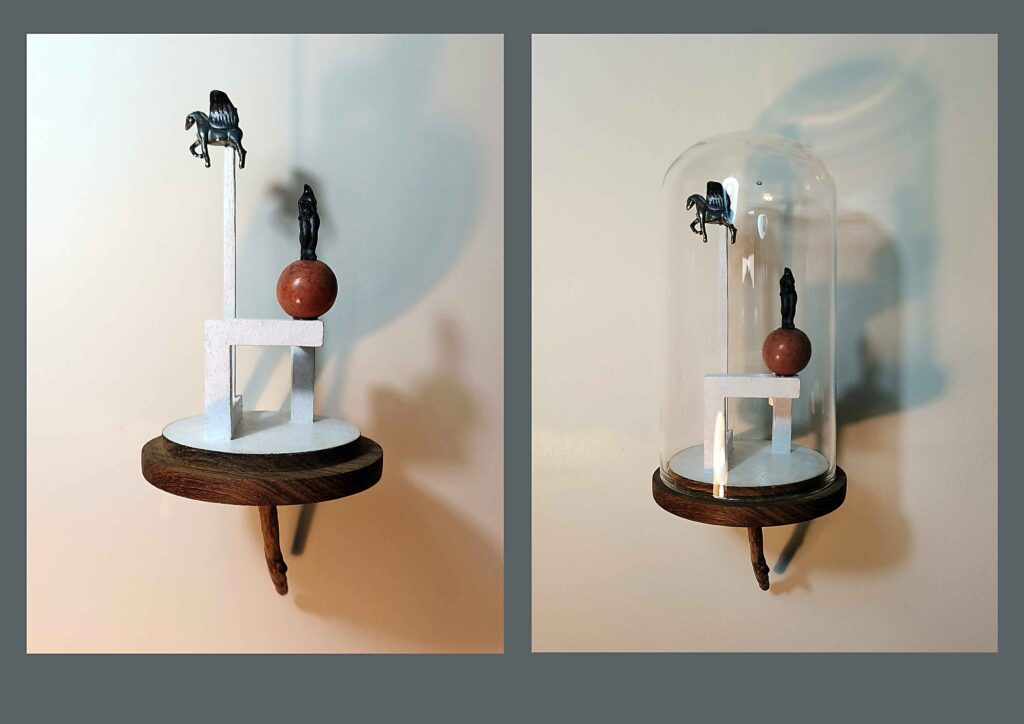
Compound, Wood, Terracotta and Glass, 8 x 4.5 inches, 2022
GK: Art can be a significant investment. How do you guide collectors and buyers in making informed decisions when purchasing art from your gallery?
RS: We try to enhance knowledge by way of talks, and symposia, both physical and online. We have a very popular art event called Art Mela where affordable art is sold for the average young collector and the prices range from a thousand to about 2 lakhs, or 3 lakhs at the most. So, whatever anyone is buying is authentic art of very high quality because it either comes from the CIMA Awards list or it comes from National Award winners or from State Award winners. That’s the guarantee we give our buyers. So, no matter what you are buying, whether it’s a piece of folk or tribal art, that also comes from state award winners and national award winners. So, everything that the young collector is collecting would turn into value. Any good art, not to forget, even if there is no signature, is bound to escalate in value. For instance, when we buy a 19th-century or even a miniature, most of them wouldn’t have any signatures, so how do we judge them? We judge them by sheer quality and authentication. So, when a gallery ensures that quality, then your investments are ensured and intact.
GK: How do you curate exhibitions that tell a compelling story or convey a specific message to the audience?
RS: As you know, there are various ways of curating exhibitions. Sometimes there could be a story element. However, we normally do not ask artists to paint on a particular theme or an idea. We select works of artists which fit into a particular theme or idea we are exploring. Suppose I am curating an exhibition on post-covid after the pandemic. I will never ask an artist to paint on the pandemic. I would never do that! Instead, I would pick up artists who have worked on the challenging times and then select the very best that would unravel a story. Every exhibition has to talk about an idea and it has to be made interesting. We avoid using a lot of pedantic phrases and jargons; we present our curatorial notes in very simple language which an average viewer can understand. We don’t want to intimidate an average viewer with a lot of art historical jargons. We unravel a story or an idea and we explain the idea in very simple language. We always have curatorial boards accompanying all exhibitions. When we started in 1993, there were hardly a handful of curated exhibitions. It was mainly solos with very little text. Shows were organized and artworks were sold. But CIMA started curating shows in a big way. Many of our shows were art historical. They had some historical basis, reference and context.
GK: Can you share an example of a challenging ethical decision you’ve had to make as a gallery director/curator and how you resolved it?
RS: Yes, I remember we had the exhibition Sidewinder where there was a woman artist from England who had frontal nude self-portraits which were part of the exhibition. In Calcutta, we had absolutely no problem but in some cities like Delhi we did face problems. We were confronted by a group of hostile people who did not agree with what they saw. They came and were very offended by what they saw and created a ruckus. However, the government immediately helped us and the issue was resolved. There was a lot of trepidation. We have a wonderful artist called Shakila who comes from a Muslim background. So, often during her exhibitions, we get hate mails from both the communities. Hate mails from Hindus because she is a Muslim and she has drawn Kali. The Muslim community gets angry with her because she paints Kali. So, both ways Shakila is harassed. However, we take it in our stride and resolve matters. CIMA believes in the freedom of expression and we try not to compromise.
GK: What role do you see art galleries playing in promoting diversity and inclusivity in the art world? Do you have any favorite galleries from India whose work is commendable?
RS: Each gallery has its own prerogatives. We had always made our activities very inclusive. CIMA right from 1996 (when we took 200 artworks to London) one quarter of the space wasdevoted to art from the folk and the ethnic community. They were represented by the finest. We worked with the Crafts Council, and the Government of India. We featured some wonderful ethnic art. So, CIMA right from the beginning has included creative folk and ethnic artists and till date they have always featured in our mainstream art exhibitions. Take somebody like Shakila, an artist on whom the Government of India has recently made a documentary film. She started her life on the pavements of Kolkata and she is one of our finest artists today. Today she is in her 50s and she has a studio, a home. When she started off, she lived in a little mud-house in the outskirts of Kolkata. We feel very proud that she has received several awards in India. Yes, our programmes have always been extremely inclusive cutting across caste, creed and gender.
GK: How do you balance the need to support emerging artists with the demands of
showcasing established, high-profile artists in your gallery?
RS: The CIMA Award’s program is 500% for young artists, the age group being from 21- 49 and nobody below or above can be a part of that; so, it’s for only the young emerging artists. This is a non-profit activity for us and we are devoting a lot of resources, energy, and rigor to the show and I think it’s one of our best programs and we will be loyal to it as long as we can continue. That’s our focus currently, and of course, the high-profile artists are there. I have created endowments which look after a lot of our non-profit work, and these endowments to be very honest have been formed through the sale of works of our famous and high-profile artists. They helped me to create these endowments and so we can work for both sectors. After all, you have to show the finest to the young community and to the young artists as well; they must be able to see what went ahead of them. After all the legacy has to be honoured. The senior artists provide inspiration, the backdrop and context to the young emerging generation.
GK: How has the digital age and online platforms impacted the traditional gallery model, and how have you adapted to these changes?
RS: In CIMA everything has been digitalized now, right from archives to everything has been
digitalized and I remember when in 1993 we used to have catalogs, those catalogs were horrendous because of the way we designed them and I think quality wise we have improved a lot in the digital era and it’s so much faster and even new media art is entering the art scene in a big way. However, we haven’t ventured into the crypto (NFT’s, the digital assets).
GK: What trends have you observed in the art world in recent years, and how do they influence CIMA’s programming?
RS: Cima encourages experimentation and we have delved in new media in a big way. However, our activities are based on excellence and rigor. We like to look at the future without being overtly trendy.
GK: What initiatives do you have in place to support the professional development and well-being of your gallery staff and artists?
RS: Our staff are members of a family. Right from the onset the same staff has been with us except one or two who have retired. We have stuck to an old brigade and they have been trained over the years and are now masters in their own game. They have solved problems; they have traveled across the country with our art and so they indeed play a vital role. We love traveling our art. Unfortunately, traveling has become very expensive and sometimes we also face occasional problems as we lack wide-body jets within the country. So, we have to go via road. The other problem is that visual art does not exist in the policy framework of our government. As a result, the taxations and other norms are not rationalized. That has to begin and we are taking it up with the government. In my individual capacity as Art Director of FICCI we had done a policy framework paper for the Government of India but it has not been acted upon as yet. The entire ecosystem of visual arts has to be re-structured and freshly framed. That has not happened and because art per se as a term does not exist in the lexicon of Indian governance. We have faced problems with art coming from abroad which is subject to luxury tax. So no art from abroad can be imported and no galleries from abroad like to join our art fairs because it is not viable for them. These things have to be sorted out and I think a lot of work has to be done in this area. The other aspect we lack is Art Associations. Every country has art associations and unless we have these associations, there is nobody to talk on behalf of the art community and for the sector in general.
GK: What advice would you give to aspiring art galleries and directors who aim to succeed in the competitive art world while staying true to their artistic vision and values?
RS: I always say that the life of an art gallery simulates the life of an artist. The artist has to be true to his art and the gallery has to be true to its artist and to the art. Now, if my aim is only to make money then that can become very troublesome. Abroad I have found that most of the established galleries, have their respective art contexts. I understand that there is an artist’s initiative Nippon Gallery which has come up in Bombay which is fabulous. I wish more and more such institutions come up where they think seriously about the artists and their art. The motto of the gallery must be to nurture talent and to be involved with showcasing talent. If you show good art and you establish your credibility, money will eventually come, but initially, you have to invest in earnest work. Somehow in India, the tendency is to commercialize very early. A serious art gallery must invest in promoting serious art and artists and nurture talents. Nurturing artists is an expensive proposition and it has to be done very patiently and in a dedicated manner.
GK: How do you engage with and nurture emerging artists? What advice would you give to artists seeking representation?
RS: Young artists also, in fact, I have been entering into a dialogue with a lot of art institutions and suggesting that during the last semester, they need to introduce the artist to his professional world. We counter a lot of artists who have absolutely no idea of their professional world. They lack knowledge and acumen on pricing, packing, freighting, and all that goes with the business of art commerce and relations with galleries. So, all art institutions should devote several sessions in inviting gallerists, art historians, media and letting the artist know what this world is all about. Because, if he is not apprised of this, then he doesn’t know how to face that domain and conduct himself in a proper way. Even artists are often taken for a ride. I always say, if you give your artwork to a gallery, please ask for a receipt. He should understand that there are hundreds of thugs ready to cheat artists. By the time an artist emerges from an art institution after his training, he should be reasonably conversant with the functioning of the art world. All art teaching institutions should be aware of this vital need.
Rakhi Sarkar has left an indelible mark on the world of art as an eminent art curator and promoter of CIMA. Her dedication to promoting Indian art on a global level, her commitment to diversity and emerging talent, and her contributions to art education and research are testaments to her lasting impact. Not only has she transformed the cultural landscape of Kolkata, but she has also played a vital role in connecting India with the global art community. Rakhi Sarkar’s legacy as a trailblazer in the art world will inspire generations of artists and enthusiasts for years to come.
Read More>> Please Subscribe our Physical Magazine